Infinite thanks!
Infinite thanks to everyone who participates in our math adventures – kids, parents, teachers, readers, developers, artists, writers, researchers! Thank you, friends!

You can make your own fractal words with FractType, and nested fractals with PhotoSpiralysis.
Posted in Make
Inspired by calculus: Friday math circle, Week 3
All the photos from this club | Parent notes
This week we had a high-energy meeting with longer flows. When I run math circles, I prepare about five times more activities than I think I’ll need. Sometimes an activity does not work, and we switch. Other times there is good flow, but it only lasts a short time per activity, and we hop to something else. This “hopping” often happens in new groups, as you could see in Week 1. That’s because I am inviting participants to a new exciting land – a new contextual neighborhood to explore, in this case, looking at infinity, infinite sequences and cycles, infinitesimally small objects, and change. The following weeks, I try to focus on types of activities the kids liked, or questions they asked. To follow the travel analogy: at first I drive kids around on a tour bus. Next, we take day trips to the areas kids pointed out through the bus windows. My design goal is self-organized learning within most of the activities. I may point out an interesting feature to explore (such as slope of rides, when you build an amusement park) – but then kids do most of their own poking around. Some kids want to keep working on activities for a long time. It’s a hard decision to try and invite them to switch tasks, because in general, you want kids to work on what interests them for as long as possible…
Is this unschooling, or Sudbury freeschooling, or Reggio Emilia? Yes and no. Parents and I follow children’s interests a lot, and each kid has the freedom not to do each proposed activity (though there is the group pressure). The big difference is that I do stir kids toward a particular contextual neighborhood. The GPS is rigged to point to calculus. Wherever kids go, there they are near infinity, change in functions, cycles and series… One funny effect many parents report: kids see infinity everywhere! In branching trees, in love that never ends, in generations of families that go on…
Kids are right: calculus is everywhere, because it is a way of describing any object, much like storytelling or photography. You can take a photo or tell a story of anything whatsoever. Or you can make a mathematical model of anything, using a big math area like calculus, or using one powerful concept. When we went on the scavenger hunt for symbols, kids pointed at everything: toy cars (model-symbols of real objects), words (name-symbols of objects), light switches and outlets (action-symbols as means of control, and indicator-symbols), facial expressions or gestures (index-symbols of moods or actions)… “Symbol” for kids – and for mathematicians – is a tool for describing all of the world. Seeing math everywhere is very similar to the magic of pretend-play.
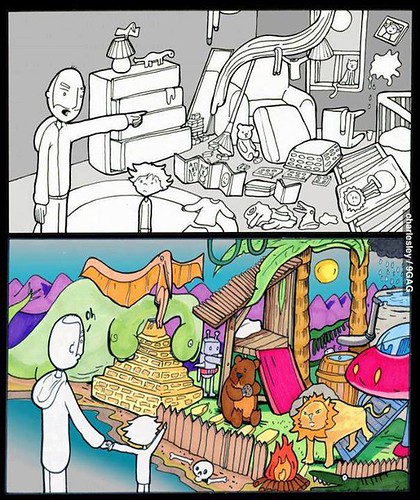
Thanks to Dor Abrahamson, my contextual neighbor, for this week’s discussions and references (1, 2, 3) about children’s symbols.
Share your favorite things. We continue to seek math in the favorite things kids bring. It’s a little the circle-starting ritual. In this case, a Lego person fighting a vine! Sure, we could find a lot of numbers, but what about infinity? Wouldn’t it be nice if LEGO blocks went to infinity? “All over the house! All the way up to space!”
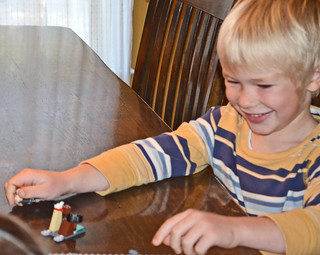
Slopes. Jill the amusement park manager and her trusty droid helper Jack are building some rides. They start with no slope – or rather, zero slope – because it’s the easiest to program. But the park visitors are demanding steeper and steeper slopes…
Kids started with free building (towers, animals, etc.) but as I told the story and built “rides with slopes,” shifted to structures with slopes. Children only need to pay a bit of attention for this shift to happen, maybe 20-30% of their attention, if that. Here we are comparing our slopes:
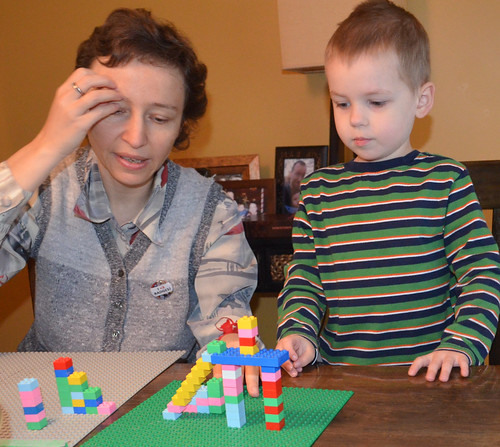
Kids don’t necessarily like constant slopes, or pay enough attention to consistency to keep their slopes constant. In the future, I will probably stress the change of slopes more, and consistency less. We want changing slopes anyway to get to the calculus ideas like tangents and limits! At home: notice slopes!
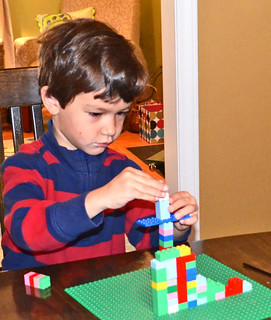
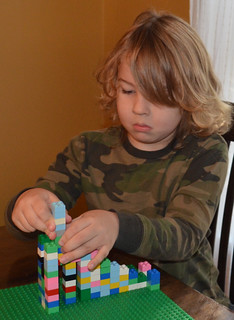
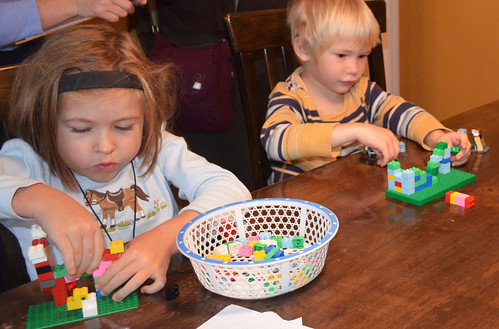
Symbols. Kids asked about symbol activities from the last time, so we continued. What do you love? Make up a symbol for it! This is a simple but rich task. As most maker tasks, it requires analysis of ideas and some skill with crafting. Kids did not know at first what can symbolize Spiderman, or all animals. “What if I can’t draw any animal?”
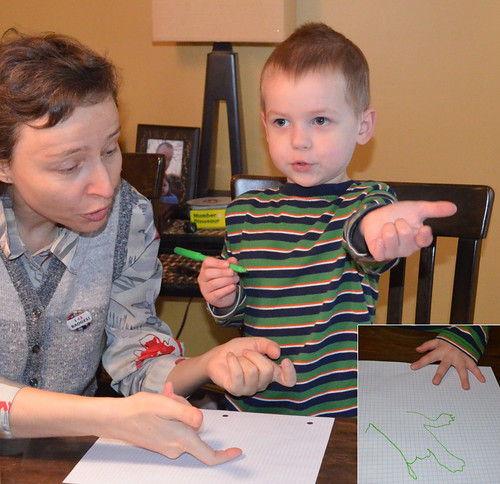
“This is what Spiderman does!”

“And the symbols for all the web Spiderman shoots.”
To help those who get stuck with drawing, hold the kid’s hand in yours. Don’t guide any more than the kid wants: you mostly help the kid to keep the hand steady. Talk through the drawing: “We are doing the head first – it’s a big circle. Ears are triangles. Now the body, even bigger and more like a curvy oval…”

At some point, most kids take their hand away and draw on their own. At home: make up all sorts of symbols, and notice symbols. Here are a few types kids like:
- Iconic symbols show what they symbolize, like Batman’s bat silhouette
- Models are toy or simplified versions of objects that stand for real objects in pretend-play
- Names are words. Is “mom” a name symbol?
- Abstract symbols have no connection between their look (or sound) and their meaning, for example, 5 for five objects or five units of length.
- Action-symbols control something, like a light switch
- Indicators show something is going on, for example, most stoves have lights that show the stove is hot
Weird pictures. Kids drew objects, and parents helped them make tree (branching) fractals out of these objects. Or at least enough levels for kids to imagine the structure going to infinity!

Fractals connect ideas of infinity, cycles, zoom – and are very handy for introducing powers and logarithms. Fractal thinking is a powerful tool for understanding the nature – and for making beautiful art.

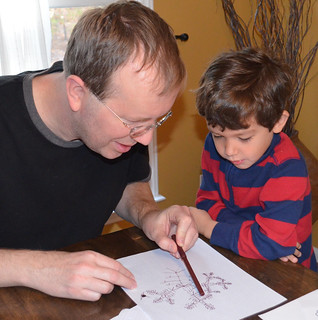
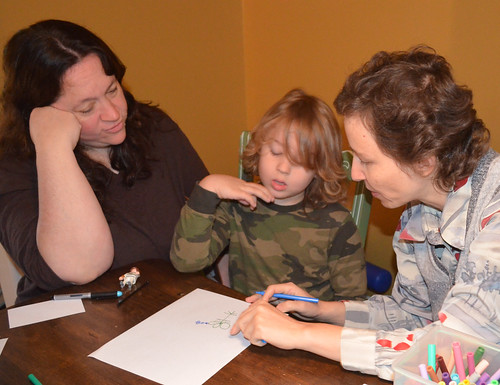
Some kids like to draw abstract shapes. They may tell what shapes mean, or not. It’s okay if children art does not look like anything; consistent abstract patterns are mathematically interesting, and have their own beauty. This abstract piece had a big story to it:
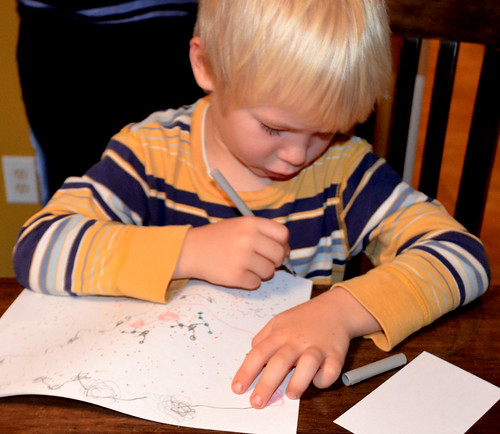
Videos for inspiring fractal art. Fractal hand and Cows&Cows&Cows, by the same author, cyriak.

Bonus: a Droste Effect (nested doll fractal) flower.

Posted in Grow
Inspired by Calculus: Friday math circle, week 2
These are notes about young calculus adventures at a family Math Circle, a part of the Inspired by Calculus series. This week, we worked more on iterations and growth functions, and started to look at symbols. Thank you for the notes, Sue and Andrea! Thank you for taking pictures for our gallery, Linda and everybody who helped!
Parents had the quest: collecting data about the level of freedom in children’s activities.
You can download or print the current version of the quest. When I design activities, I aim at one of these three levels of freedom, but sometimes I miss:
- Problem Solving. Students receive problems with known answers. They have the freedom to use, develop, or acquire any method of solving the problems.
- Inquiry. Students receive open-ended problems with infinite possible answers. They have the freedom to interpret the nature of answers, as well as choose methods of solving the problems.
- Self-Organized Learning. Students choose (or accept an offer of) a broad starting area, and pose problems or projects within that area. They have the freedom to make their own problems, to interpret the nature of answers, and to choose methods of solving their problems.
LEGO function machines. Last time, we had a function that added one to inputs. This time, I asked kids to change the rule about differences. As a side note, kids often try to suggest the same exact rule or pattern you have offered before. They may or may not realize it’s the same, because they have “appropriated” your idea for themselves! You can just explore the pattern again. Or you can point out the similarity, and praise the kids for their understanding of the idea. There are three aspects of these activities that have to do with calculus. First, I invite kids to imagine the iterations of the function machine going on and on and on – to infinity. Several kids commented on such infinite growth being difficult, or spooky, which we should acknowledge and discuss. Children don’t have barriers against the depth of math ideas, which is a good thing for learning, but also somewhat dangerous if adults push. Mason: “I can’t imagine that – because I don’t want to go to infinity.” Second, I talk about the outputs of these function machines in terms of differences. When kids suggested the machine that adds two, Traver really got into the spirit of helping with the differences and prepared a whole bunch of two-block towers.

Third, we check if the result is a straight-line slope or not. I use the word “linear.” When I asked for yet another function machine idea, Mason made up the identity function: one block comes in, one block goes out… forever.

This was funny for kids, which is typical of extreme case scenarios (multiplying by one or zero, adding zero, identify function and so on). Well, until we run out of blocks and space. Engineering-minded kids like to point out limitations of our physical space. It is a fun scavenger hunt: what stops us from going to infinity and beyond? At home: come up with rules for your own function machines.
Free building. This took place at the same time as discussions of function machines.

Lucas built pyramids (we checked if the sides were straight lines), Mason made several constructions including a “periodic tower,” and Traver made a square pattern.

I invited kids to grow the square pattern more. We worked on it together for a while, and then I made towers out of layers of the pattern.

Do the towers made out of perimeters of squares have linear growth? Are they supposed to? I think kids got tired by that time, so I doubt they were analyzing the situation much at all, beyond the initial exposure. We will return to these questions later. Free building allows us to continue exploring what kids start – that is, to help them deepen their own ideas. At home: continue to support free play. Find math in what kids do, and point it out for them.
Scavenger hunt for symbols. I gave a couple of examples, and said that symbols are signs that mean something, and off we went around the house to look for some.

The first example was the pumpkin and the word “Halloween” as symbols of Halloween, on a toy Mason brought. I never described or defined symbols in detail, because it does not matter. The idea of symbols is a human universal, meaning that every culture has some sort of symbols. Human universals are everywhere around us, and kids pick them up – even if they don’t know the words. After just a few examples, kids were pointing out all sorts of symbols, such as the word “kiss” for love, a toy truck decal for a particular truck show, a barcode for an apple price, and the upward position of the light switch for turning lights on.
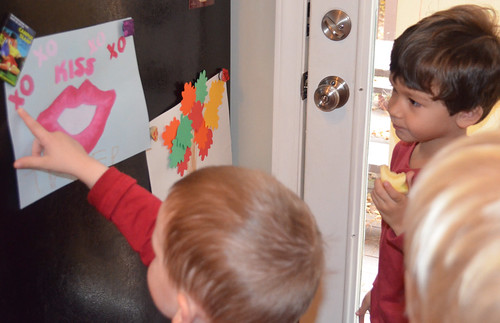
This last is an example of a beautiful aspect of young children’s thinking about symbols. If you ask grown-ups for examples of symbols, they come up with abstract signs (like 5 for five objects) or icons (like wheelchair for handicapped parking). But kids come up with objects as well, like the light switch. Researchers used to connect this with magical thinking (like a shaman using a doll to “cause” rain), but it’s about modern interface design. A button, a switch, or a slider are symbols for actions – but symbols that do cause actions to happen. “Any sufficiently advanced technology is indistinguishable from magic” – Arthur Clarke. At home: seek more symbols!
We had a neat little conversation about symbols when Eric and Traver were helping me bring stuff to the car. Traver gave me an oak leaf and said it means good luck.
- Maria: Is this leaf a symbol of luck?
- Traver: Yes!
- Maria: Why?
- Traver: …
- Eric: What makes you think it is for good luck?
- Traver: … (silence often means you are asking questions that are very far from how kids think)
- Maria: Is there something in the way the leaf looks that makes it lucky? Or is it an abstract symbol – just so symbol?
- Traver: Just so symbol!
You will see kids use abstract symbols for ideas, and make abstract drawings. When we ask kids to explain reasons, or to make their drawings look like objects (representational art), we can close some doors to abstraction. Let’s celebrate just so drawings, just so symbols, and other abstract play.
Apple math. We repeatedly cut an apple in half.

Older kids usually predict that the number of pieces will go 2, 4 – then 6 (since kids are used to counting by twos). Younger kids had no such issue! They saw the situation for what it was, without preconceived notions. It’s typical for kids to compare graphs or other math entities to familiar objects.

The grown-up version of the same mini-game is making pictures out of graphs. Desmos, my favorite grapher, hosts a nice collection.

Video: Infinity elephants. Because most of the kids can’t yet draw or build like Vi Hart, or relate to much of her funny speech, the video was very abstract for them. Yet they watched to the end, and their doodles afterwards were very mathematical. I wonder if our math activities inspire kids to draw more math.
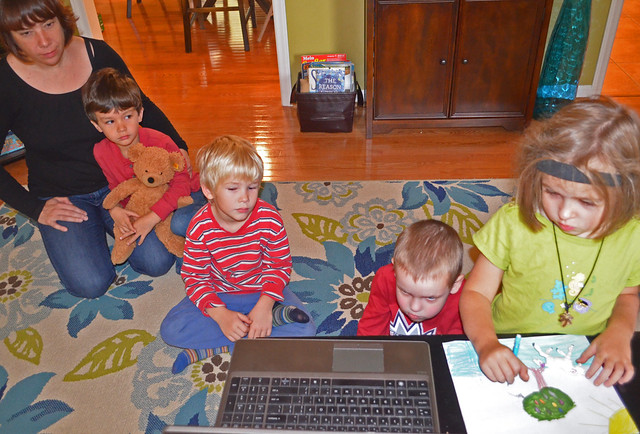
Math-rich doodles. I like to analyze math aspects of children art. For more than ten years, I’ve been collecting kid pictures of grids, like Lucas made. Please send me yours if your kids make them.
If you see math elements in pictures, you can invite kids to do more of the same type of math, at deeper levels. They appreciate it, because you follow their ideas. Here is where I want to invite kids based on their free doodles:
- Mason made many-eyed aliens, Travor made a version of a smiley fractal I drew, and Lizzie made a version of Vi Hart’s Apollonian Gasket noodle. We will do more art based on these ideas of grouping (aliens), branching (smileys) or partitioning (gasket).
- Grids, of course, like Lucas made – they lead to a lot of math, from coordinate planes to integration in calculus. I want to invite kids to make curvy shapes out of square blocks as one version of grid art.
- Mason’s circles within circles is, like grids, another recurring pattern in children art. They remind me of nested dolls. This pattern, and also spirals, has to do with infinity. The nested squares kids built out of LEGO are similar. Lucas had circles within circles going. Trying to completely cover the page with many lines is another recurring train in children art.

- Travor made a Ferris wheel – it’s a variation on a theme with regular intervals, like grids have. We may go on a scavenger hunt for patterns made out of regular intervals, or changing intervals. This can be related to what we are doing with functions.
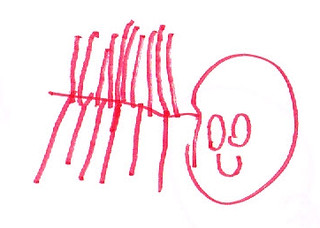
Mason made a spider with “many, many legs” – a similar motif.

I don’t claim kids see these connections, yet. But if grown-ups see the connections, they can start from children’s own art, and take children to bold math adventures.
Posted in Grow
Fluency or Complexity
I am very proud of my 6-year old and the math discoveries he makes. Two days ago he came up with a proof that zero is an even number. Yesterday he built something he called “a square that has volume” (a cube), then connected 4 of them into a larger cube. And today, well before I had time to drink my morning tea, he shared his new discovery – turns out, Russian nesting dolls are fractal!

I am very concerned about my 6-year old’s struggles with math. He still gets mixed up counting past 10. He is shaky with his math facts. He still needs to use fingers, counting bears or abacus a lot.
Where am I going with this? At the last Inspired by Calculus math circle, the kids were building LEGO towers so that the number of blocks in each tower was double the number in the previous tower – 1, 2, 4, 8, 16… It seemed that most of the kids, including my son, struggled with the doubling part. Whether they multiplied or added, they kept making mistakes. The goal of this building activity, by the way, was to check whether such doubling function would be linear or non-linear. Which got me wondering whether I am putting the proverbial carriage ahead of the proverbial horse when it comes to my child’s math education.

When I talk to friends about advanced math for very young kids, one of the first reactions I get is, “This is cool and I’d like to try it with my child just as soon as he learns to count/add/multiply.” When I say that many of the activities can be done with kids who don’t know any of these things yet, or are not fluent yet, the question I get most often is not, “How does it work.” It is, “Wouldn’t it be better to build up their arithmetic skills first?” And frankly, I ask myself this same question whenever I see my child stumbling with his “required skills” work.
Does it really have to be one or another? Is it possible to really understand complex mathematical ideas without firm grounding in basic arithmetic?
Right now, for my son and I it’s a question of enjoyment. He loves going to math circles and problem-solving with friends. I love that he notices math all around him now. He loves that doing math can be funny. (Cats need meat for breakfast, lunch and dinner. Grandpa says he needs meat for breakfast, lunch and dinner. Grandpa is a cat.) I love that he uses math to communicate complex ideas and deep observations. He loves watching Fractal Cows, Infinity Elephants and Sierpinski Dream videos. I love watching these with him.
What do you think? Does exploring deep math very early helps to “get” the fundamentals?
Posted in Grow





